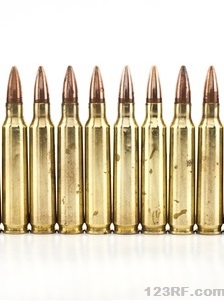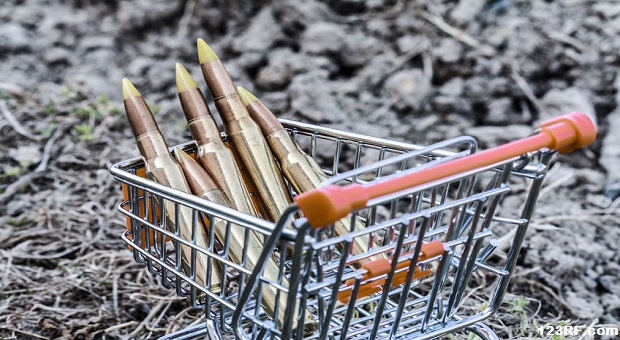Before a time of serious crisis, the survivalist should start collecting ammunition for every firearm that they own or intend to take with them. Given the nature of social collapse, it is best to avoid drawing attention to yourself while building your ammunition supply. You will also need to exercise caution in practicing skills, and buying other defense items that may be needed later on.
Buying Ammunition, Equipment and Tools
Make a point to buy your ammunition a little at a time each payday; and also buy your ammunition at many different stores instead of just one. If you purchase the ammunition at a gun show, shop around for the best price. A lot of times people buy name brands out of habit instead of looking at all of the brands.
Research the ammunition manufacturers, and keep a running list of price comparisons. In many cases other brands are cheaper, but their standards of manufacture are at the same level as the brand names. Buy some to test in your weapons to see which works the best. You can also buy ammo by phone, order blank, or on the internet, and then have it shipped to you by freight. Remember, though, there will always be an address trail through the shipper or the seller that reveals your purchase.
Even if the transaction goes through smoothly, a raid on the seller’s shipping books or detailed financial/banking transactions can reveal your information and trigger an investigation, especially if it is defined as illegal in your area.
No matter where you buy ammo from, here are some important things not to do:
- Do not buy ammunition that has a box date over 10 years old,
- Do not buy if the box or carton is ripped, broken, or the seal is not intact,
- Do not buy loose ammunition that you personally have not checked over,
- Do not buy any ammunition at a super low discount price because you may be buying ammunition “seconds”, production rejects, or stolen inventory.
How to Store Ammunition
The best way to store ammunition is in an air-tight and water-tight ammo can in a cool dry area. Regardless of the ammo can size, always include stay dry packets to manage any condensation that may form.
A 50 caliber ammo can usually holds between 500 to 1000 rounds of Centerfire ammunition depending on the caliber being stored in it. The same size ammo can can also be used to hold approximately 2000 rounds of .22 LR ammo, or 200 12 Ga shotgun shells. I also like the handles on the 50 caliber ammo cans because you can carry 2 to 4 cans at one time (as long as that is within your carrying capacity).
Another good ammo can is the 20mm. It can hold the contents of about four 50 caliber ammo cans, but may be too big and heavy for one person to manage. These ammunition containers are better used for storage at the actual base camp.
Some bulk ammunition cans or tins are already sealed, preserved, and ready for storage. These ammunition cans or tins can be opened with a large can opener that is usually supplied, by using a bayonet, or other heavy knife. This ammunition is usually packaged or boxed in a set number of rounds for the specific weapon that it is to be used in.
Things Not to Do When Storing Your Ammunition
- Do not store ammunition in a hot, cold, or wet conditions without proper containers,
- Do not bury ammunition in the ground without proper containers,
- Do not hide ammunition in easy to find places,
- Do not over pack ammunition into very heavy containers.
What is the Shelf Life of Ammunition?
The shelve life of ammunition is how long it can be stored before it starts to break down. Some things to check for:
- On full metal jacket bullets, is there rust or other corrosion?
- Rust or discoloration on the shell casings
- Corrosion in and around the primer pocket or on the primer itself.
When to Replenish Your Ammunition
 For each of your firearms you should have a set number rounds for it.
For each of your firearms you should have a set number rounds for it.
As a rule the oldest ammunition should be used first if there are no signs of ammunition break down. Use this ammunition for practice and training.
Replace the used ammunition with new. Inspect the ammunition can seals, hinges, and lock down system. If all is good, then use this ammunition can.
Write on the ammunition can ammo type, caliber, and date bought so you know the age and quantity of your inventory.
Why Reload Your Ammunition?
Reloading is essentially an ammo recycling and alteration method that can be used only with certain types. When you reload ammunition you have better quality control over the selection of the components: the bullets, cases, powders, and primers. With reloading, you can also custom tailor the ammunition to a particular firearm for the best accuracy and performance.
When you buy your components in bulk, it is also possible to lower the cost per round of ammunition. When your are first learning to reload, it is important to have a face-to-face mentor. This individual should teach you the safe way to reload ammunition. (Note explicit directions are not given in this article. Consult an appropriate reloading manual and work with a mentor so that you remain safe and learn how to reload properly. Often, what looks simple on paper can turn into a disaster if even one step is overlooked).
How to Reload Your Ammunition Safely
- Always follow the manufacturers printed step by step instructions in the presence of your mentor.
- Practice with dry runs until you become familiar with the reloading equipment, and you feel satisfied that you are ready to begin to reloading live ammunition.
- For Centerfire ammunition reloading, choose the best smokeless powder and bullet design to use from the reloading handbook. This book reveals minimal to maximum bullet and smokeless powder weights.
- For shot shell ammunition reloading, select smokeless powder and shot size to use from a shot shell reloading handbook. This handbook will list minimal to maximum shot charges and smokeless powder weights.
Tips and Equipment for Reloading
For Centerfire Pistol and Rifle
- Reloading manual: This book gives the reloader all of the important data to safely reload all of the popular centerfire pistol and rifle ammunition. It covers bullet weight, powder charge, type of primer, average velocity, and type of shell case.
- Reloading press: This is the most important tool in the reloading process. The press gives the reloader the the mechanical advantage and a platform to deprime the case, full case resizing, seating of primers in the case primer pocket, aiding with dispensing the powder charge when using a powder measuring device, and seating the bullet.
- A good manual balance powder scale to measure the smokeless powder charge. This scale when balanced will give you a very accurate measurement of smokeless powder to be used safely in the bullet casing.
- Bullet case lubricant kit: If the bullet cases do not have a thin coating of lubricant there is a chance that it will get stuck in one of the reloading dies.
- Bullet case trimmer: When a bullet fires, the case expands just a little. After a couple shots the bullet case becomes too long to be safely reloaded and must be shortened back to a safe length.
- Case measuring ruler: The ruler tells the reloader the exact length of the case. Next check the measurement against the go, no go table in the reloading manual. If the case is to long to use, cut the case back to specs with the case trimmer.
- Reloading bullet trays : These trays are designed to hold the bullet case in the up right position so they do not fall over in the reloading procedure. They come in sizes for either centerfire pistol or rifle cases.
- A good set of reloading dies and a shell holder: For each caliber of ammunition that you reload there must be a set of reloading dies with the corresponding shell holder.
My personal pick for a reloading system is the RCBS Rock Chucker Supreme Master Reloading Kit. Priced at $349.99 is an excellent value for a complete starter system. The only thing required with this kit is a set of dies and shell holder for each caliber that you are going to reload.
Rifle 2 die sets run between $77.95 to $92.95 each depending on caliber. Shell holder are priced at $14.95 each. Pistol 3 die carbide sets are are $65.95 each in all the popular calibers. Shell holders are priced at $14.95 each. This whole reloading system can be stored in a footlocker for a fast bug out.
To Reload Shot shells:
- A good shot shell reloading manual: This manual gives the reloader all the necessary information to safely reload all of the popular shot shells. This manual covers powder charge, shot charge, type of primer, and type of shot shell casing.
- A good reloading press: This is the most important tool in the shot shell reloading process. This press gives the reloader the mechanical advantage and a platform to deprime the shot shell, prime the shot shell, dispensing a powder charge when using a powder measuring device, lines up and inserts the wad, measures and inserts the shot, and crimps down the the top of the shot shell.
- A powder and shot bar: This bar holds the bushings that measure fixed powder and shot weights to be loaded in to the shot shell.
- A good manual balance powder scale: This measuring device gives a very accurate measurement of the smokeless powder charge to be used safely in the shot shell.
- Reloading shot shell trays: Used to hold and organize the shot shells when finished reloading.
My pick for a shot shell reloader is the Lee Load-All Reloader. They are made in 12Ga., 16 Ga., and 20 Ga. Each of these reloaders are priced at $57.99 each. The only thing you might want to add is an optional primer feed.The 12 Ga. and the 20 Ga. will reload 2 3/4 and 3“ shot shells. The 16 Ga. reloader only reloads 2 3/4 shot shells.
Things Not to do When Reloading Ammunition:
- Do not drink alcoholic beverages,
- Do not smoke or have open flames burning,
- Do not eat while reloading,
- Do not use cell phones or text while reloading,
- Do not watch TV,
- Do not use a digital scale, no power no work,
- Do not try to reload 22 rimfire ammunition – it is beyond the scope of this article, and also beyond most people that do reloading.
Final Words
In conclusion, the prepper must know how to collect, store, replenish, and reload ammunition. These simple techniques will help you survive and maintain the vital ammunition supplies that you own. Try to make your storage containers small, light, and easy to carry.
Be a knowledgeable buyer when it comes to buying ammunition, storage containers, reloading equipment, and reloading components. Learn how to reload all the types of ammunition for all of the weapons that you own. Be safe and keep your powder dry.
by Fred Tyrell








